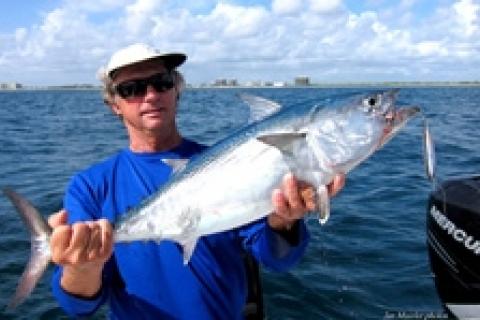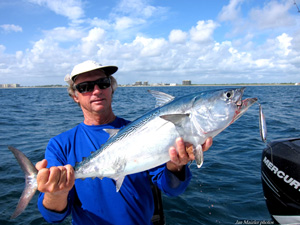
The southeast coast of Florida has an annual run of bonito (false albacore) every summer.
Their "Gold Coast appearance" occurs sooner and in more shallow water around Jupiter — in the northern part of this range — than in the Greater Miami area to the south.
 |
| Capt. Butch Constable holds up big bonito taken on a surface plug. |
Capt. Butch Constable has been one of Jupiter's pioneers in developing strategies for casting artificial lures to nearshore gamesters, including bonito. This veteran skipper learned long ago that live bait chumming for bonito creates a far more exciting and effective prelude to casting artificials to these breaking fish. On Florida's east coast, there are far less surface breaking bonito schools — and they need live chum to get them going.
In contrast to the west coast of Florida, Gold Coast bonito rarely make as much of an inshore appearance tearing up vast minnow schools like they do off Crystal River to Naples. While bonito have invaded the southeast coast near Stuart to eat small "whitebait", that is more of an exception. Pursuing bonito from Jupiter to Miami without live bait like pilchards would easily cut down casting results by 75 percent.
Preparation
Butch's day always begins by netting live bait. Bonito are present during the summer months — a time when pilchards (whitebait) are abundant either in the Intracoastal Waterway, Jupiter Inlet or along the areas' beaches. Butch tries to completely fill his huge livewell on his 29-foot Twin Vee so he has ample bait to live-chum the bonito all day long.
Once the bait is stored in the huge well-aerated livewell and the decks are hosed down, he heads from the mouth of Jupiter Inlet to areas that are either currently hotspots or time-tested likely spots like shallow water reefs and wrecks — some of which may hold large amounts of bait themselves. The perks of a bonito encounter off Jupiter is that it starts barely a mile from the Inlet and features speedsters as heavy as 15-17 pounds, which is larger on average than Florida's west coast.
The live chum are the hors d' oeuvres and the artificial lures are the main course. And the secret of any appetizer is to whet the appetite, not satisfy it, but with fast-moving fish like bonito, it's hard to overfeed a fish with such strong caloric needs. Bear in mind that surface-breaking bonito can cover an area the size of an end zone. But the rule remains that only after Butch has them thoroughly chummed up do the lures — like plugs and jigs — get cast.
One phenomenon that occurs with live chumming the bonito is that some live chum may ball up and run from the boats' transom — with many of the bonito following. In those cases where the new blowups show within 100 yards of his vessel, Butch fires up his twin 300 H.P. Verados and gets right back on the fish in less than a minute.
Double Task Fishing Day
By now, you've no doubt understood that there's two steps in this specialty: catching the pilchards for chumming and casting to the chummed-up bonito. And, frankly, the first part of this process is often the hardest part.
Two and possibly three skills required are spotting the bait and then throwing the cast net or either using Sabiki or gold hook rigs for at least an hour. Most specialists keep a daily running fix on the baits' location from other captains or anglers. Here's where good "connections" and a simple cell phone call can get you over to large areas of bait without much searching.
 If you do not get a tip from other boats, then looking for diving birds, dimpling bait or other boats using cast nets should get you there. If you want to catch the bait most quickly, throwing a cast net is the way to do it. Therefore, you must learn to throw a cast net proficiently as well as know what size net and mesh to use. Alternatively, if the bait is large, you might catch them on tiny hooked rigs but it will take you hours to get the quantity you need. Lastly, if there is a live bait boat around, you can buy some live chum from them, but at a very high price.
If you do not get a tip from other boats, then looking for diving birds, dimpling bait or other boats using cast nets should get you there. If you want to catch the bait most quickly, throwing a cast net is the way to do it. Therefore, you must learn to throw a cast net proficiently as well as know what size net and mesh to use. Alternatively, if the bait is large, you might catch them on tiny hooked rigs but it will take you hours to get the quantity you need. Lastly, if there is a live bait boat around, you can buy some live chum from them, but at a very high price.
Tackle
The best casting tackle for jigs and plugs is medium spinning tackle spooled with 15-pound line — either braid or monofilament. My own preference is "mono", but braid works fine for bonito and will not slingshot back because these gamesters bite down hard on the lure and do not thrash and shake their heads. The spinning reels must feature a huge line capacity (long runs), ultra smooth drag (fast runs) and very fast retrieve ratio (best retrieve). The rods must have the kind of action that can cast tiny minnow — resembling lures yet have the backbone to handle fish that are like seagoing torpedoes. The rod material can be S-glass or graphite.
Terminal tackle should feature fluorocarbon leader since bonito have such sharp vision. Leader invisibility is quite important when the seas are glassy calm, but if the waters are choppy and the fish exploding aggressively, monofilament leaders are acceptable. Forty-pound test should be more than adequate since bonito can be thought of as "toothless". The lures should always be tied to the leader with a loop knot like a Uni-Knot or Homer Rhode. Loop knots maximize freedom of lure action.
Lures
Always remember in your lure choices to match the hatch, meaning that your lures should be the same size as your chum as well as match the size of any bait schools encountered "naturally" offshore or near shore. The two major aspects of lure choice are profile (shape and size) and color. You can count on success if you employ silver or white with a slim looking profile and modest sink rate. The most popular sinking lures are white bucktails, silver spoons and soft plastic jigs with the aforementioned colors.
Be absolutely sure you are using saltwater-style lures so the hook is strong and sharp.
Fish-resembling soft plastics like the Money Minnow are excellent as well, provided they match the size of what the bonito are feeding on.
The other lure that is the most fun to use are surface plugs. The most effective actions are the surface walking type of plug. It is wise to re-fit your plug from two treble hooks to two single hooks. Treble hooks mutilate bonito and make it too long and dangerous to unhook them.
The Release
Bonito must move to stay alive so unhook them as quickly as possible, pose them for a photograph, and release back into the water the way you would throw a football. This latter method of release gets them "started" properly.
- 5929 views

